Employee Relations: Conflict, Bargaining, and Negotiation
VerifiedAdded on 2020/03/23
|20
|4873
|147
Report
AI Summary
This report delves into the multifaceted realm of employee relations, exploring the interplay between employers and employees within a dynamic organizational context. It begins by defining the pluralistic and unitary frames of reference, providing a lens through which to understand differing perspectives on workplace dynamics. The report then examines the influence of trade unionism on employee relations, tracing its evolution and impact on employment practices. It identifies the key players in employee relations, including government, trade unions, employees, and employers, outlining their respective roles and responsibilities. The report further investigates the nature of industrial conflict, detailing the processes for conflict resolution, and highlighting the key features of employee relations in conflict scenarios. Finally, it touches upon collective bargaining and negotiation, though the details of this section are not fully present in the provided text. The report aims to provide a comprehensive overview of employee relations, emphasizing conflict management, and the importance of understanding diverse perspectives in fostering a productive and harmonious work environment.
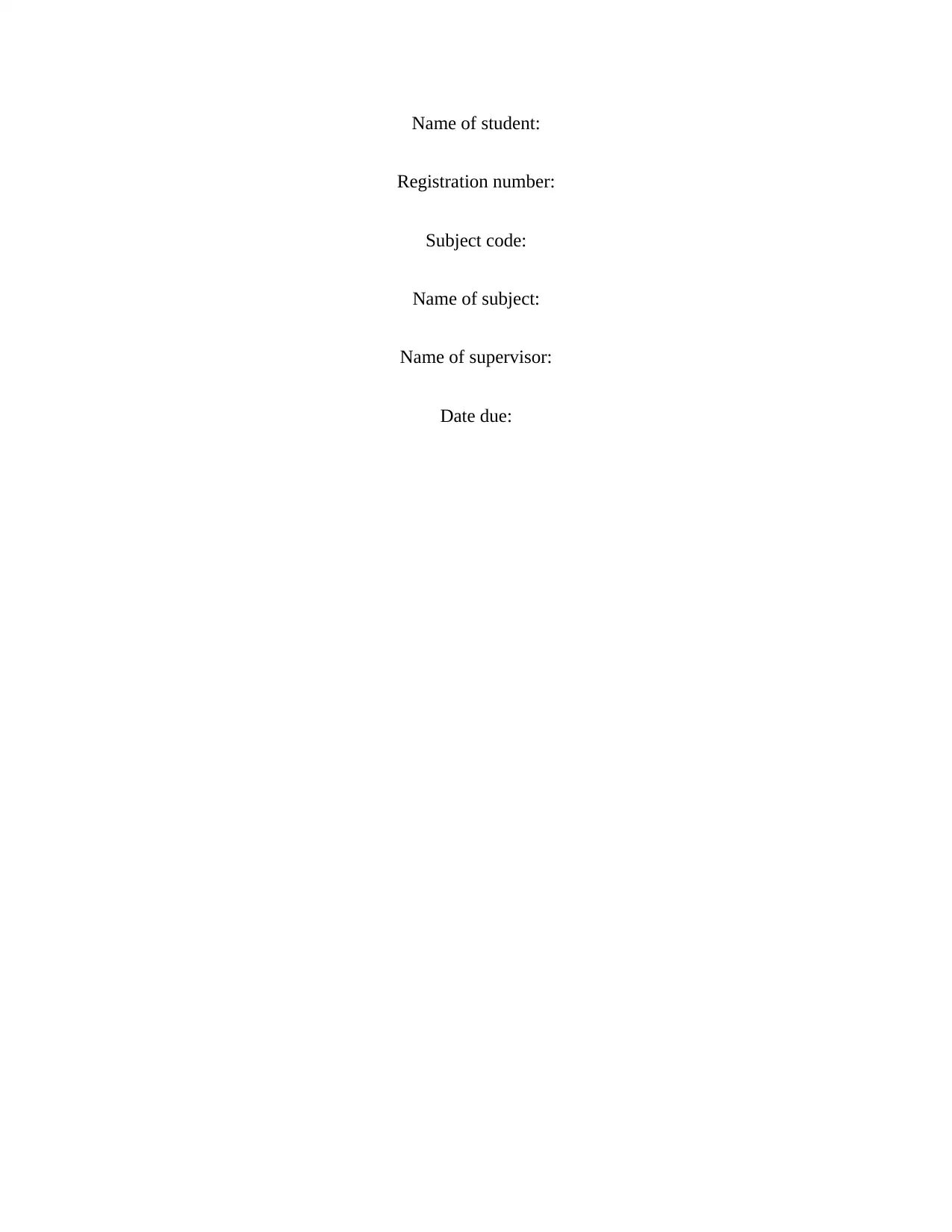
Name of student:
Registration number:
Subject code:
Name of subject:
Name of supervisor:
Date due:
Registration number:
Subject code:
Name of subject:
Name of supervisor:
Date due:
Paraphrase This Document
Need a fresh take? Get an instant paraphrase of this document with our AI Paraphraser

TASK 1
LO1. UNDERSTAND THE CONTEXT OF EMPLOYEE RELATIONS AGAINST A
CHANGING BACKGROUND
Pluralistic frame of reference
The pluralistic frame of reference is used in the organization setting to refer to a situation in
which an organization is made up of numerous distinct subgroups each with a leader and
particular group objectives. This frame of reference is based on the belief that organizations are
made up of members with different interests. According to this perspective conflicts among the
members of an organization occur as result of the various interests possessed by members of the
organization. Differences in remuneration and violation of rights are viewed to be the primary
cause of conflict under this perspective and such conflicts are solved through collective
bargaining (Amossé, et al,2016).
Unitary frame of reference
Unlike in the pluralistic viewpoint, unitary perspective has its foundation on the belief that
members of an organization exist as a single unit with similar interests (Lewis, Thornhill &
Saunders,2012). These group interests guide the working of both managers and employees. As a
result of the existence of similar interests chances of conflicts are not common. This perspective
is based on the belief that for an organization to achieve ultimate success its members must share
similar, objectives, values and goals and that the achievement of such goals and objectives is a
signifier of success. However, conflict may arise due to different individual and organizational
interests. These conflicts can be resolved through the adoption of effective communication
strategies (Armstrong & Armstrong, 2011).
LO1. UNDERSTAND THE CONTEXT OF EMPLOYEE RELATIONS AGAINST A
CHANGING BACKGROUND
Pluralistic frame of reference
The pluralistic frame of reference is used in the organization setting to refer to a situation in
which an organization is made up of numerous distinct subgroups each with a leader and
particular group objectives. This frame of reference is based on the belief that organizations are
made up of members with different interests. According to this perspective conflicts among the
members of an organization occur as result of the various interests possessed by members of the
organization. Differences in remuneration and violation of rights are viewed to be the primary
cause of conflict under this perspective and such conflicts are solved through collective
bargaining (Amossé, et al,2016).
Unitary frame of reference
Unlike in the pluralistic viewpoint, unitary perspective has its foundation on the belief that
members of an organization exist as a single unit with similar interests (Lewis, Thornhill &
Saunders,2012). These group interests guide the working of both managers and employees. As a
result of the existence of similar interests chances of conflicts are not common. This perspective
is based on the belief that for an organization to achieve ultimate success its members must share
similar, objectives, values and goals and that the achievement of such goals and objectives is a
signifier of success. However, conflict may arise due to different individual and organizational
interests. These conflicts can be resolved through the adoption of effective communication
strategies (Armstrong & Armstrong, 2011).
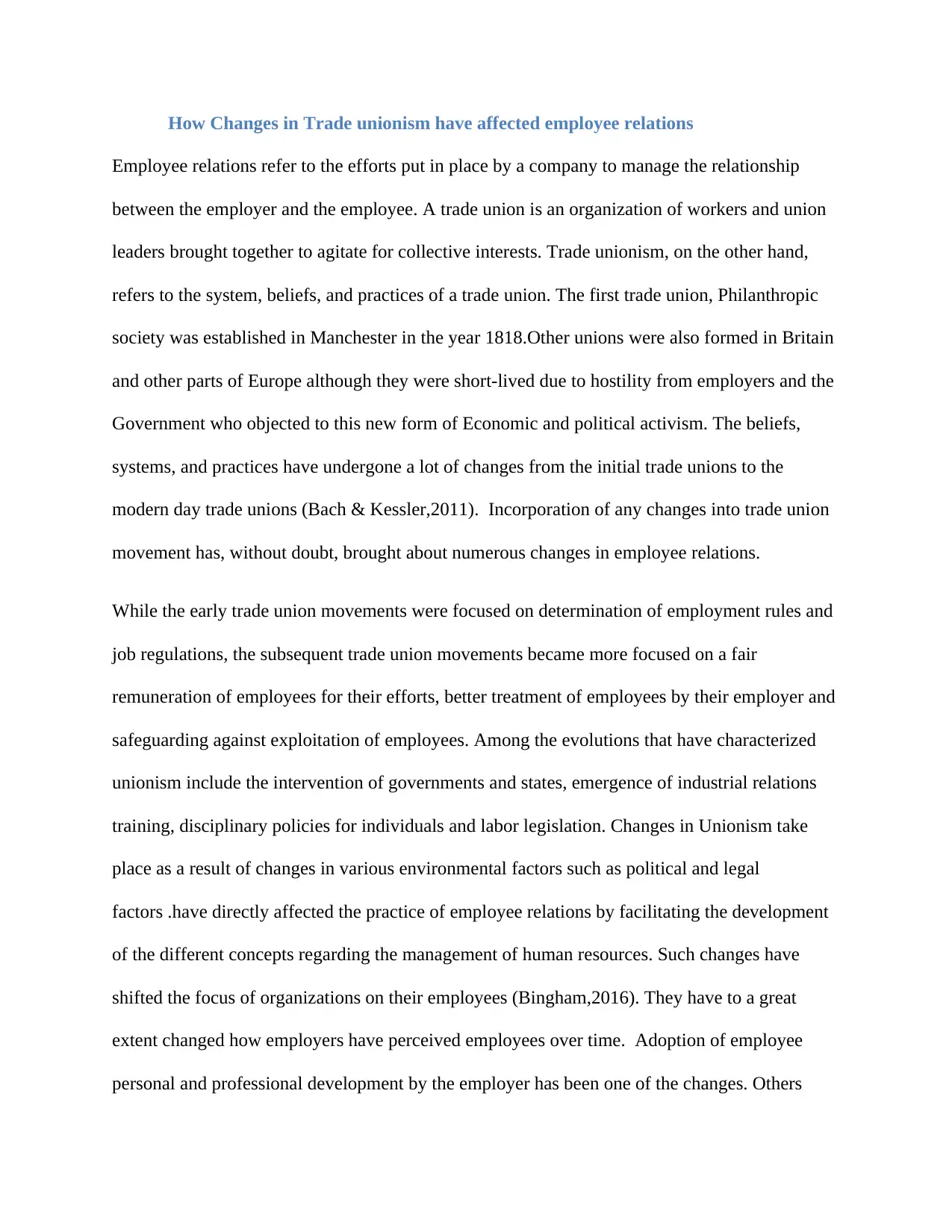
How Changes in Trade unionism have affected employee relations
Employee relations refer to the efforts put in place by a company to manage the relationship
between the employer and the employee. A trade union is an organization of workers and union
leaders brought together to agitate for collective interests. Trade unionism, on the other hand,
refers to the system, beliefs, and practices of a trade union. The first trade union, Philanthropic
society was established in Manchester in the year 1818.Other unions were also formed in Britain
and other parts of Europe although they were short-lived due to hostility from employers and the
Government who objected to this new form of Economic and political activism. The beliefs,
systems, and practices have undergone a lot of changes from the initial trade unions to the
modern day trade unions (Bach & Kessler,2011). Incorporation of any changes into trade union
movement has, without doubt, brought about numerous changes in employee relations.
While the early trade union movements were focused on determination of employment rules and
job regulations, the subsequent trade union movements became more focused on a fair
remuneration of employees for their efforts, better treatment of employees by their employer and
safeguarding against exploitation of employees. Among the evolutions that have characterized
unionism include the intervention of governments and states, emergence of industrial relations
training, disciplinary policies for individuals and labor legislation. Changes in Unionism take
place as a result of changes in various environmental factors such as political and legal
factors .have directly affected the practice of employee relations by facilitating the development
of the different concepts regarding the management of human resources. Such changes have
shifted the focus of organizations on their employees (Bingham,2016). They have to a great
extent changed how employers have perceived employees over time. Adoption of employee
personal and professional development by the employer has been one of the changes. Others
Employee relations refer to the efforts put in place by a company to manage the relationship
between the employer and the employee. A trade union is an organization of workers and union
leaders brought together to agitate for collective interests. Trade unionism, on the other hand,
refers to the system, beliefs, and practices of a trade union. The first trade union, Philanthropic
society was established in Manchester in the year 1818.Other unions were also formed in Britain
and other parts of Europe although they were short-lived due to hostility from employers and the
Government who objected to this new form of Economic and political activism. The beliefs,
systems, and practices have undergone a lot of changes from the initial trade unions to the
modern day trade unions (Bach & Kessler,2011). Incorporation of any changes into trade union
movement has, without doubt, brought about numerous changes in employee relations.
While the early trade union movements were focused on determination of employment rules and
job regulations, the subsequent trade union movements became more focused on a fair
remuneration of employees for their efforts, better treatment of employees by their employer and
safeguarding against exploitation of employees. Among the evolutions that have characterized
unionism include the intervention of governments and states, emergence of industrial relations
training, disciplinary policies for individuals and labor legislation. Changes in Unionism take
place as a result of changes in various environmental factors such as political and legal
factors .have directly affected the practice of employee relations by facilitating the development
of the different concepts regarding the management of human resources. Such changes have
shifted the focus of organizations on their employees (Bingham,2016). They have to a great
extent changed how employers have perceived employees over time. Adoption of employee
personal and professional development by the employer has been one of the changes. Others
⊘ This is a preview!⊘
Do you want full access?
Subscribe today to unlock all pages.

Trusted by 1+ million students worldwide

include workforce remuneration policies, resolution of disputes through negotiations and
collective bargaining, more involvement of employees in decision-making, focus on employee
safety among others. As a result of these changes, employees are treated more as partners than
subordinates. It has also made organizations focus on eliminating any possible causes of disputes
to safeguard themselves against any losses resulting from industrial action (Blanpain &
Baker,2010).
Role of players in employee relations
Employee relations is an area that requires the input of many industrial players for its success.
However, the burden rests with the top management who are expected to put in place all the
necessary measures to ensure that there are positive relations between them and the employees at
all time.
Government
The role of the government is legislative. It is the responsibility of the government to come up
with various laws that guide the relationship between employees and their employer (Blyton &
TurnbulL,2014).The government also plays a significant intervention role on matters employee
relations. Some of Government’s regulations and legislation include protecting the rights of both
the employer and employee, regulating incomes and prices and managing the economy.
Trade Unions
A trade union is made of individuals working for the same employer or different employers who
join hands to protect their rights and interests and strengthen their bargaining power. Trade
unions focus on the duties and responsibilities of employees, rights and rules guiding them.
collective bargaining, more involvement of employees in decision-making, focus on employee
safety among others. As a result of these changes, employees are treated more as partners than
subordinates. It has also made organizations focus on eliminating any possible causes of disputes
to safeguard themselves against any losses resulting from industrial action (Blanpain &
Baker,2010).
Role of players in employee relations
Employee relations is an area that requires the input of many industrial players for its success.
However, the burden rests with the top management who are expected to put in place all the
necessary measures to ensure that there are positive relations between them and the employees at
all time.
Government
The role of the government is legislative. It is the responsibility of the government to come up
with various laws that guide the relationship between employees and their employer (Blyton &
TurnbulL,2014).The government also plays a significant intervention role on matters employee
relations. Some of Government’s regulations and legislation include protecting the rights of both
the employer and employee, regulating incomes and prices and managing the economy.
Trade Unions
A trade union is made of individuals working for the same employer or different employers who
join hands to protect their rights and interests and strengthen their bargaining power. Trade
unions focus on the duties and responsibilities of employees, rights and rules guiding them.
Paraphrase This Document
Need a fresh take? Get an instant paraphrase of this document with our AI Paraphraser
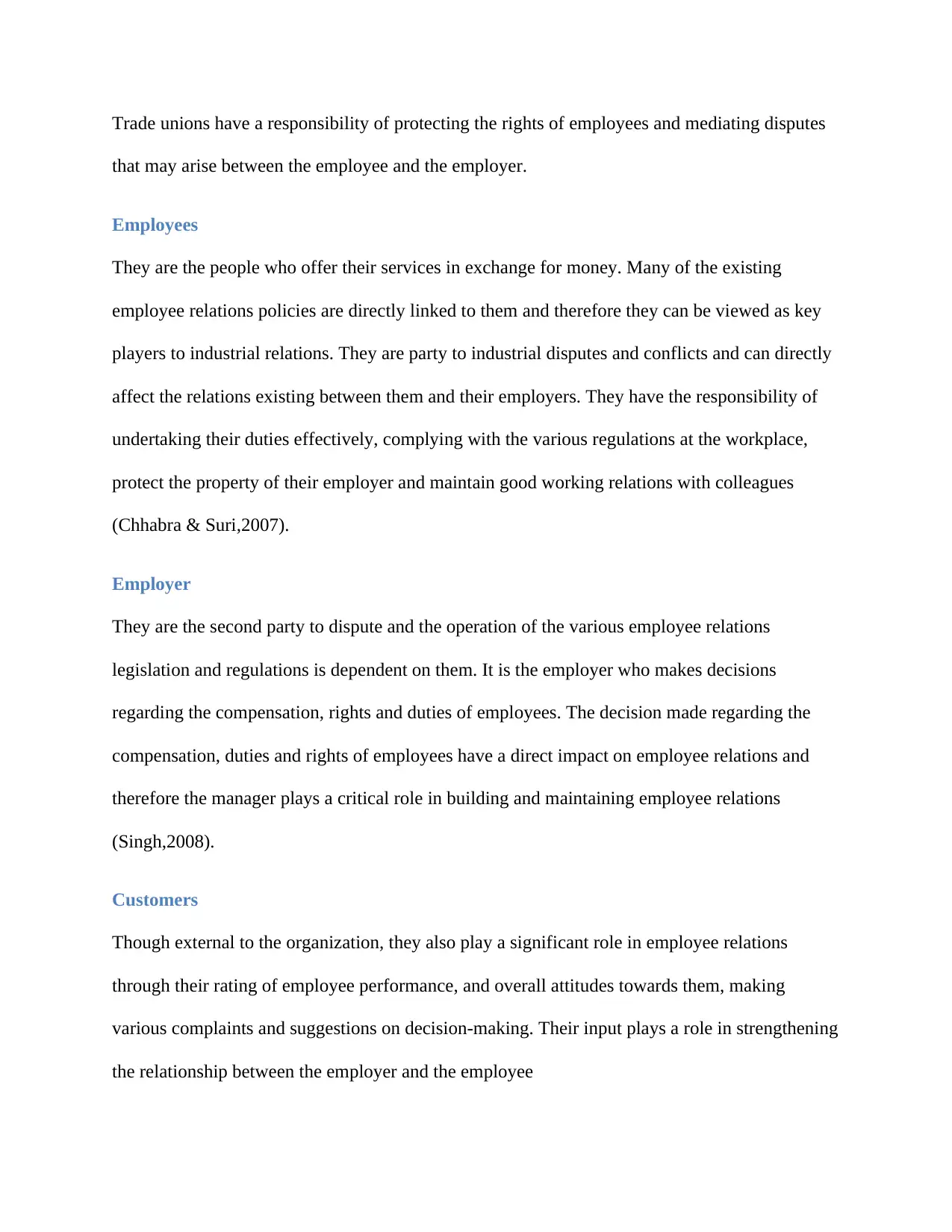
Trade unions have a responsibility of protecting the rights of employees and mediating disputes
that may arise between the employee and the employer.
Employees
They are the people who offer their services in exchange for money. Many of the existing
employee relations policies are directly linked to them and therefore they can be viewed as key
players to industrial relations. They are party to industrial disputes and conflicts and can directly
affect the relations existing between them and their employers. They have the responsibility of
undertaking their duties effectively, complying with the various regulations at the workplace,
protect the property of their employer and maintain good working relations with colleagues
(Chhabra & Suri,2007).
Employer
They are the second party to dispute and the operation of the various employee relations
legislation and regulations is dependent on them. It is the employer who makes decisions
regarding the compensation, rights and duties of employees. The decision made regarding the
compensation, duties and rights of employees have a direct impact on employee relations and
therefore the manager plays a critical role in building and maintaining employee relations
(Singh,2008).
Customers
Though external to the organization, they also play a significant role in employee relations
through their rating of employee performance, and overall attitudes towards them, making
various complaints and suggestions on decision-making. Their input plays a role in strengthening
the relationship between the employer and the employee
that may arise between the employee and the employer.
Employees
They are the people who offer their services in exchange for money. Many of the existing
employee relations policies are directly linked to them and therefore they can be viewed as key
players to industrial relations. They are party to industrial disputes and conflicts and can directly
affect the relations existing between them and their employers. They have the responsibility of
undertaking their duties effectively, complying with the various regulations at the workplace,
protect the property of their employer and maintain good working relations with colleagues
(Chhabra & Suri,2007).
Employer
They are the second party to dispute and the operation of the various employee relations
legislation and regulations is dependent on them. It is the employer who makes decisions
regarding the compensation, rights and duties of employees. The decision made regarding the
compensation, duties and rights of employees have a direct impact on employee relations and
therefore the manager plays a critical role in building and maintaining employee relations
(Singh,2008).
Customers
Though external to the organization, they also play a significant role in employee relations
through their rating of employee performance, and overall attitudes towards them, making
various complaints and suggestions on decision-making. Their input plays a role in strengthening
the relationship between the employer and the employee
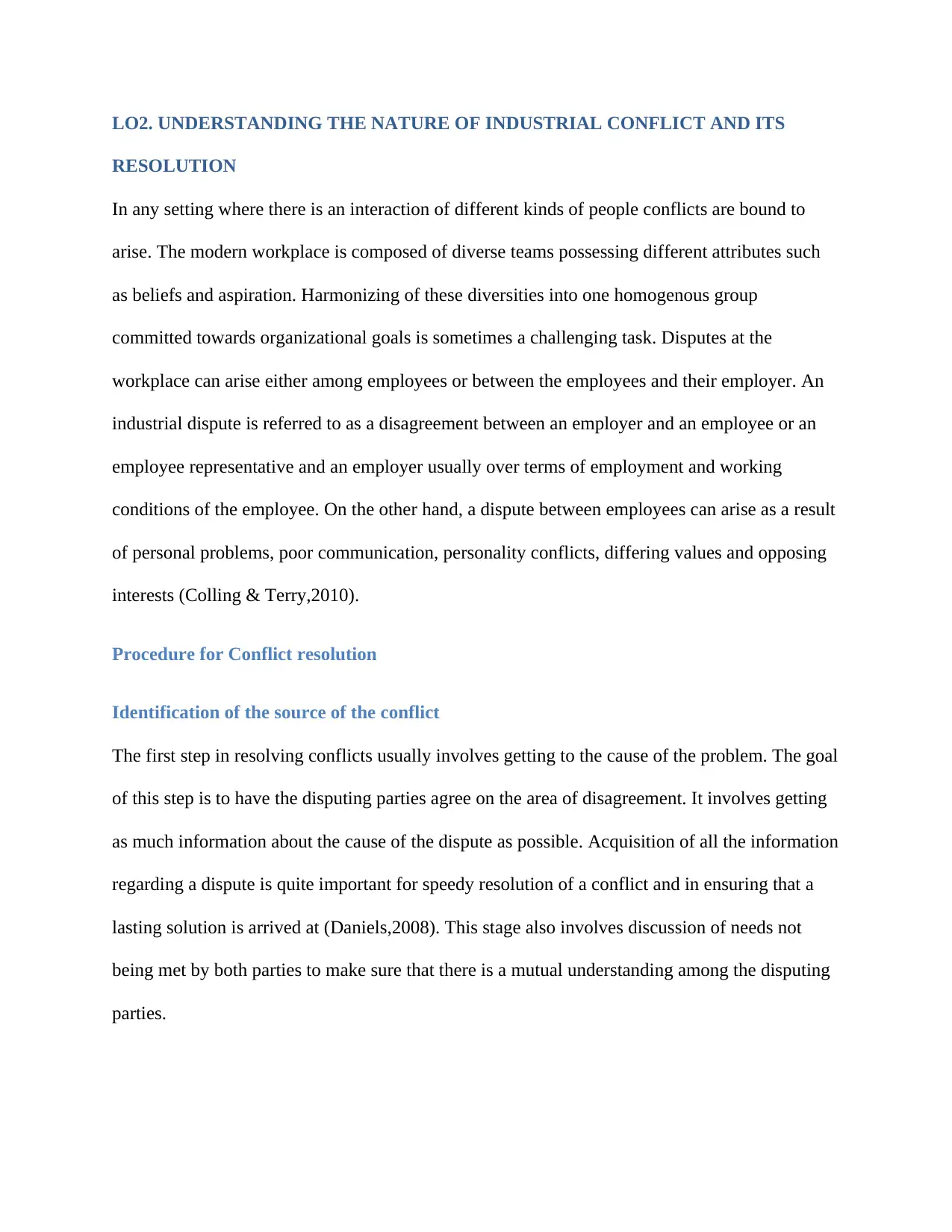
LO2. UNDERSTANDING THE NATURE OF INDUSTRIAL CONFLICT AND ITS
RESOLUTION
In any setting where there is an interaction of different kinds of people conflicts are bound to
arise. The modern workplace is composed of diverse teams possessing different attributes such
as beliefs and aspiration. Harmonizing of these diversities into one homogenous group
committed towards organizational goals is sometimes a challenging task. Disputes at the
workplace can arise either among employees or between the employees and their employer. An
industrial dispute is referred to as a disagreement between an employer and an employee or an
employee representative and an employer usually over terms of employment and working
conditions of the employee. On the other hand, a dispute between employees can arise as a result
of personal problems, poor communication, personality conflicts, differing values and opposing
interests (Colling & Terry,2010).
Procedure for Conflict resolution
Identification of the source of the conflict
The first step in resolving conflicts usually involves getting to the cause of the problem. The goal
of this step is to have the disputing parties agree on the area of disagreement. It involves getting
as much information about the cause of the dispute as possible. Acquisition of all the information
regarding a dispute is quite important for speedy resolution of a conflict and in ensuring that a
lasting solution is arrived at (Daniels,2008). This stage also involves discussion of needs not
being met by both parties to make sure that there is a mutual understanding among the disputing
parties.
RESOLUTION
In any setting where there is an interaction of different kinds of people conflicts are bound to
arise. The modern workplace is composed of diverse teams possessing different attributes such
as beliefs and aspiration. Harmonizing of these diversities into one homogenous group
committed towards organizational goals is sometimes a challenging task. Disputes at the
workplace can arise either among employees or between the employees and their employer. An
industrial dispute is referred to as a disagreement between an employer and an employee or an
employee representative and an employer usually over terms of employment and working
conditions of the employee. On the other hand, a dispute between employees can arise as a result
of personal problems, poor communication, personality conflicts, differing values and opposing
interests (Colling & Terry,2010).
Procedure for Conflict resolution
Identification of the source of the conflict
The first step in resolving conflicts usually involves getting to the cause of the problem. The goal
of this step is to have the disputing parties agree on the area of disagreement. It involves getting
as much information about the cause of the dispute as possible. Acquisition of all the information
regarding a dispute is quite important for speedy resolution of a conflict and in ensuring that a
lasting solution is arrived at (Daniels,2008). This stage also involves discussion of needs not
being met by both parties to make sure that there is a mutual understanding among the disputing
parties.
⊘ This is a preview!⊘
Do you want full access?
Subscribe today to unlock all pages.

Trusted by 1+ million students worldwide

Establishment of a common goal among the parties
Goal setting is quite important in amicable solution to a conflict. Establishment of common goals
enables both parties to participate fully in the conflict resolution. Under this step, the disputing
parties agree on a common outcome for the conflict. In most instances by both sides would be to
resolve the dispute amicably.
Establishment of ways of meeting the common goal
This process involves the involvement of both sides in a dispute in a brainstorming exercise and
exchanging thoughts and views. Under this step, there is tabling of all possible options that can
help in the achievement of the goal set by the parties (Hollinshead, Nicholls & Tailby,2013).
Determining barriers to the common goal
After ways of meeting the common purpose have been established, both parties acknowledge
what has brought them to their current state and find out what might hinder the achievement of
the common goal. Understanding of the possible barriers to the resolution of the conflict makes it
possible to establish plans to deal with barriers when they are encountered.
Agreeing on the best way of resolving the conflict
After possible barriers have been established, the disputing parties collectively agree on the best
solution to the conflict(Kaufman, Beaumont & Helfgott, 2013). Both parties propose ideas which
are gauged against their merits and demerits until a common agreement is arrived at on the best
way of resolving the conflict. Under this stage, it is important to get to the cause of the problem
to ensure that it does not crop up again.
Goal setting is quite important in amicable solution to a conflict. Establishment of common goals
enables both parties to participate fully in the conflict resolution. Under this step, the disputing
parties agree on a common outcome for the conflict. In most instances by both sides would be to
resolve the dispute amicably.
Establishment of ways of meeting the common goal
This process involves the involvement of both sides in a dispute in a brainstorming exercise and
exchanging thoughts and views. Under this step, there is tabling of all possible options that can
help in the achievement of the goal set by the parties (Hollinshead, Nicholls & Tailby,2013).
Determining barriers to the common goal
After ways of meeting the common purpose have been established, both parties acknowledge
what has brought them to their current state and find out what might hinder the achievement of
the common goal. Understanding of the possible barriers to the resolution of the conflict makes it
possible to establish plans to deal with barriers when they are encountered.
Agreeing on the best way of resolving the conflict
After possible barriers have been established, the disputing parties collectively agree on the best
solution to the conflict(Kaufman, Beaumont & Helfgott, 2013). Both parties propose ideas which
are gauged against their merits and demerits until a common agreement is arrived at on the best
way of resolving the conflict. Under this stage, it is important to get to the cause of the problem
to ensure that it does not crop up again.
Paraphrase This Document
Need a fresh take? Get an instant paraphrase of this document with our AI Paraphraser
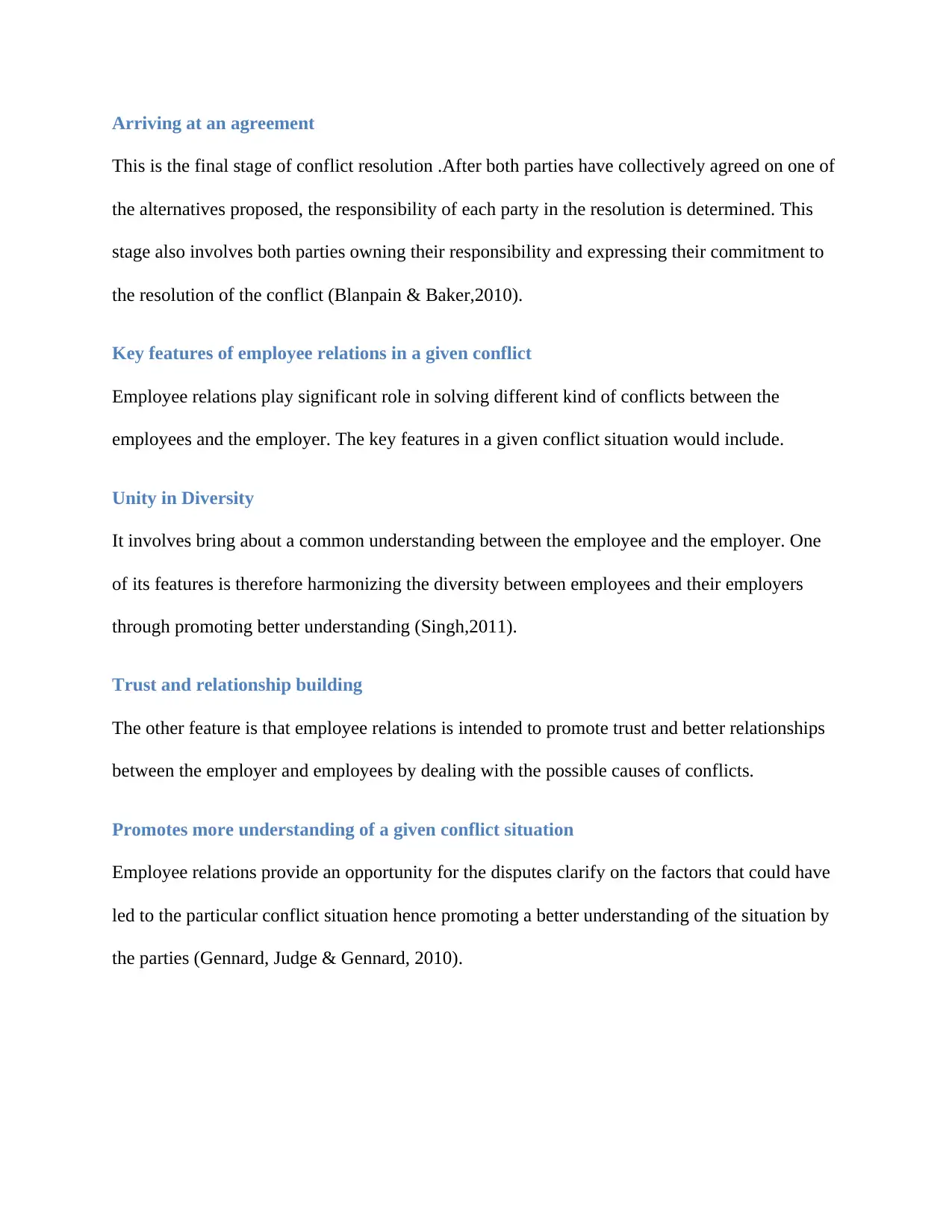
Arriving at an agreement
This is the final stage of conflict resolution .After both parties have collectively agreed on one of
the alternatives proposed, the responsibility of each party in the resolution is determined. This
stage also involves both parties owning their responsibility and expressing their commitment to
the resolution of the conflict (Blanpain & Baker,2010).
Key features of employee relations in a given conflict
Employee relations play significant role in solving different kind of conflicts between the
employees and the employer. The key features in a given conflict situation would include.
Unity in Diversity
It involves bring about a common understanding between the employee and the employer. One
of its features is therefore harmonizing the diversity between employees and their employers
through promoting better understanding (Singh,2011).
Trust and relationship building
The other feature is that employee relations is intended to promote trust and better relationships
between the employer and employees by dealing with the possible causes of conflicts.
Promotes more understanding of a given conflict situation
Employee relations provide an opportunity for the disputes clarify on the factors that could have
led to the particular conflict situation hence promoting a better understanding of the situation by
the parties (Gennard, Judge & Gennard, 2010).
This is the final stage of conflict resolution .After both parties have collectively agreed on one of
the alternatives proposed, the responsibility of each party in the resolution is determined. This
stage also involves both parties owning their responsibility and expressing their commitment to
the resolution of the conflict (Blanpain & Baker,2010).
Key features of employee relations in a given conflict
Employee relations play significant role in solving different kind of conflicts between the
employees and the employer. The key features in a given conflict situation would include.
Unity in Diversity
It involves bring about a common understanding between the employee and the employer. One
of its features is therefore harmonizing the diversity between employees and their employers
through promoting better understanding (Singh,2011).
Trust and relationship building
The other feature is that employee relations is intended to promote trust and better relationships
between the employer and employees by dealing with the possible causes of conflicts.
Promotes more understanding of a given conflict situation
Employee relations provide an opportunity for the disputes clarify on the factors that could have
led to the particular conflict situation hence promoting a better understanding of the situation by
the parties (Gennard, Judge & Gennard, 2010).

Specifying of how future conflicts should be handled
By bring the disputing parties together it helps on brainstorming on how future disputes can be
handled or avoided hence one of its features is that it provides a roadmap for resolution of future
conflicts(Lewis, Thornhill & Saunders,2012).
It helps in getting the attention of the disputing parties
Employee relations facilitates coming together of the disputing parties and provides an
opportunity for them to listen to each other views with an aim of solving the dispute
Effectiveness of procedures selected in a given conflict scenario
Any procedure adopted by the disputing parties has one main goal, to bring about the end of the
existing conflict .Whether it is a procedure for disputes between employees or between
employees and the management all have one thing in common. To end hostility and bring about
a common understanding among the disputing parties. Effectiveness is therefore determined by
the ability of the procedure to bring an existing conflict to an end. The procedure so used with
therefore be evaluated based on the time that it took to resolve the dispute whereby the most
effective would be the one that uses the shortest time (Dicker,2013). The extent to which both
parties have accepted the use of the procedure and their overall engagement in the conflict
resolution and finally the degree of enforcement and implementation of solutions arrived at
through the procedure.
TASK 3
By bring the disputing parties together it helps on brainstorming on how future disputes can be
handled or avoided hence one of its features is that it provides a roadmap for resolution of future
conflicts(Lewis, Thornhill & Saunders,2012).
It helps in getting the attention of the disputing parties
Employee relations facilitates coming together of the disputing parties and provides an
opportunity for them to listen to each other views with an aim of solving the dispute
Effectiveness of procedures selected in a given conflict scenario
Any procedure adopted by the disputing parties has one main goal, to bring about the end of the
existing conflict .Whether it is a procedure for disputes between employees or between
employees and the management all have one thing in common. To end hostility and bring about
a common understanding among the disputing parties. Effectiveness is therefore determined by
the ability of the procedure to bring an existing conflict to an end. The procedure so used with
therefore be evaluated based on the time that it took to resolve the dispute whereby the most
effective would be the one that uses the shortest time (Dicker,2013). The extent to which both
parties have accepted the use of the procedure and their overall engagement in the conflict
resolution and finally the degree of enforcement and implementation of solutions arrived at
through the procedure.
TASK 3
⊘ This is a preview!⊘
Do you want full access?
Subscribe today to unlock all pages.

Trusted by 1+ million students worldwide
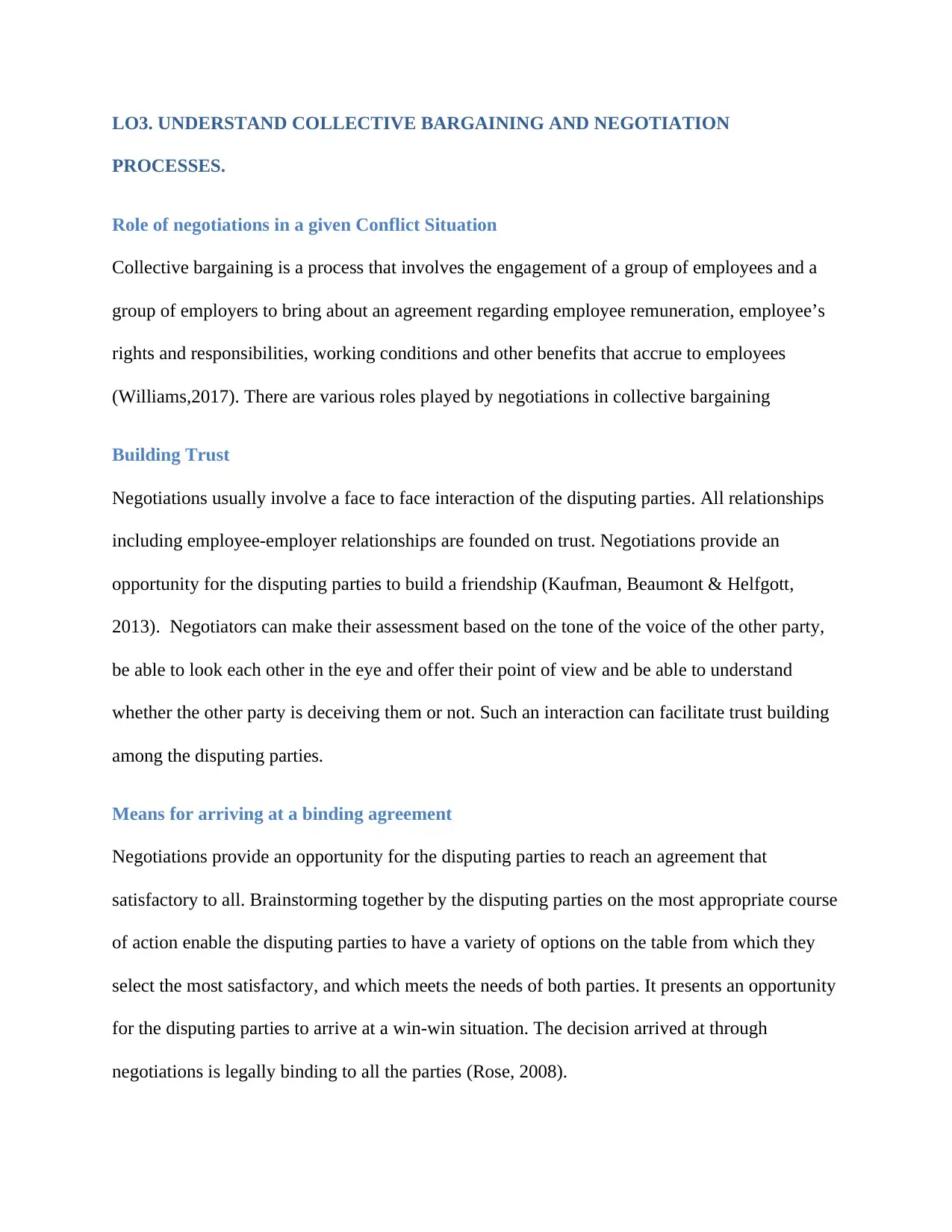
LO3. UNDERSTAND COLLECTIVE BARGAINING AND NEGOTIATION
PROCESSES.
Role of negotiations in a given Conflict Situation
Collective bargaining is a process that involves the engagement of a group of employees and a
group of employers to bring about an agreement regarding employee remuneration, employee’s
rights and responsibilities, working conditions and other benefits that accrue to employees
(Williams,2017). There are various roles played by negotiations in collective bargaining
Building Trust
Negotiations usually involve a face to face interaction of the disputing parties. All relationships
including employee-employer relationships are founded on trust. Negotiations provide an
opportunity for the disputing parties to build a friendship (Kaufman, Beaumont & Helfgott,
2013). Negotiators can make their assessment based on the tone of the voice of the other party,
be able to look each other in the eye and offer their point of view and be able to understand
whether the other party is deceiving them or not. Such an interaction can facilitate trust building
among the disputing parties.
Means for arriving at a binding agreement
Negotiations provide an opportunity for the disputing parties to reach an agreement that
satisfactory to all. Brainstorming together by the disputing parties on the most appropriate course
of action enable the disputing parties to have a variety of options on the table from which they
select the most satisfactory, and which meets the needs of both parties. It presents an opportunity
for the disputing parties to arrive at a win-win situation. The decision arrived at through
negotiations is legally binding to all the parties (Rose, 2008).
PROCESSES.
Role of negotiations in a given Conflict Situation
Collective bargaining is a process that involves the engagement of a group of employees and a
group of employers to bring about an agreement regarding employee remuneration, employee’s
rights and responsibilities, working conditions and other benefits that accrue to employees
(Williams,2017). There are various roles played by negotiations in collective bargaining
Building Trust
Negotiations usually involve a face to face interaction of the disputing parties. All relationships
including employee-employer relationships are founded on trust. Negotiations provide an
opportunity for the disputing parties to build a friendship (Kaufman, Beaumont & Helfgott,
2013). Negotiators can make their assessment based on the tone of the voice of the other party,
be able to look each other in the eye and offer their point of view and be able to understand
whether the other party is deceiving them or not. Such an interaction can facilitate trust building
among the disputing parties.
Means for arriving at a binding agreement
Negotiations provide an opportunity for the disputing parties to reach an agreement that
satisfactory to all. Brainstorming together by the disputing parties on the most appropriate course
of action enable the disputing parties to have a variety of options on the table from which they
select the most satisfactory, and which meets the needs of both parties. It presents an opportunity
for the disputing parties to arrive at a win-win situation. The decision arrived at through
negotiations is legally binding to all the parties (Rose, 2008).
Paraphrase This Document
Need a fresh take? Get an instant paraphrase of this document with our AI Paraphraser
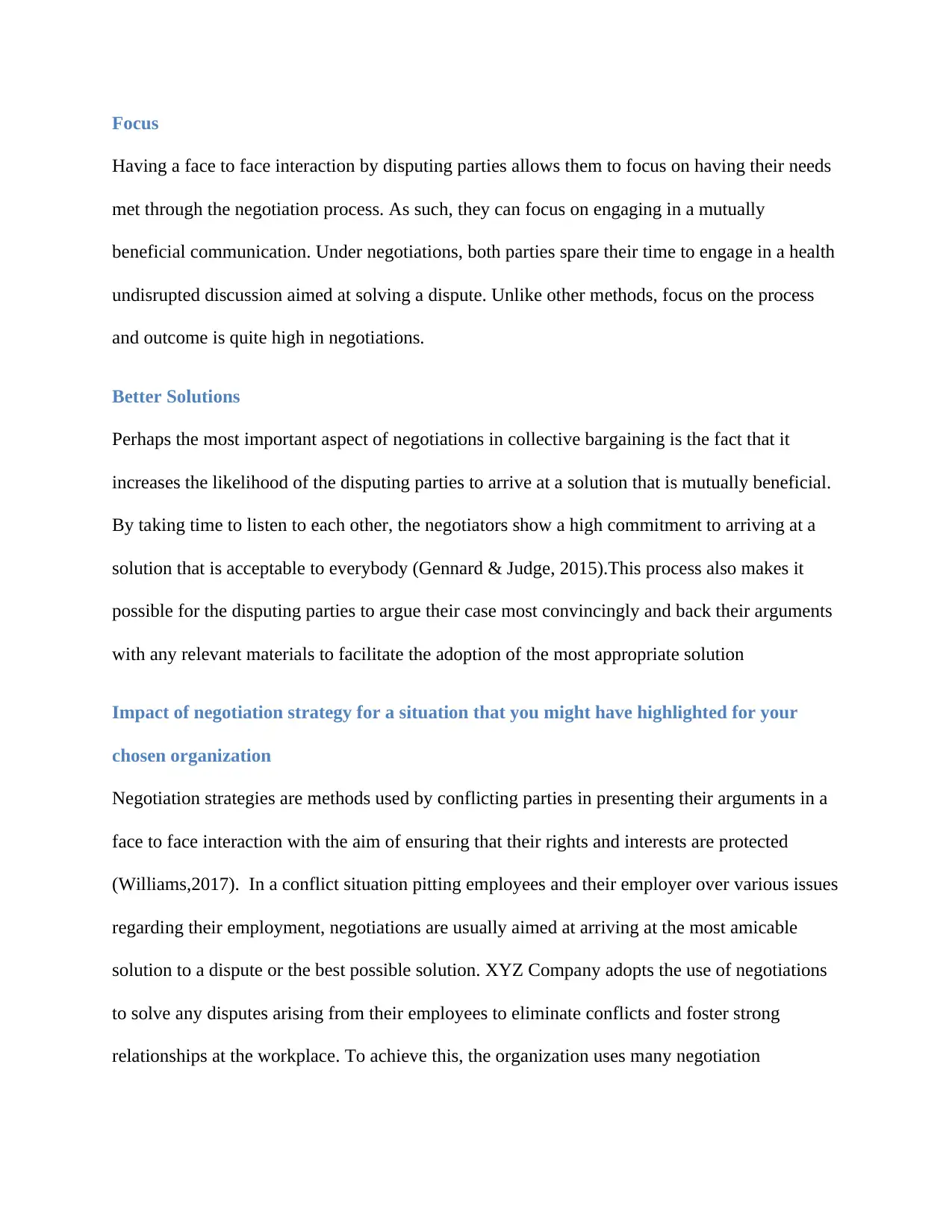
Focus
Having a face to face interaction by disputing parties allows them to focus on having their needs
met through the negotiation process. As such, they can focus on engaging in a mutually
beneficial communication. Under negotiations, both parties spare their time to engage in a health
undisrupted discussion aimed at solving a dispute. Unlike other methods, focus on the process
and outcome is quite high in negotiations.
Better Solutions
Perhaps the most important aspect of negotiations in collective bargaining is the fact that it
increases the likelihood of the disputing parties to arrive at a solution that is mutually beneficial.
By taking time to listen to each other, the negotiators show a high commitment to arriving at a
solution that is acceptable to everybody (Gennard & Judge, 2015).This process also makes it
possible for the disputing parties to argue their case most convincingly and back their arguments
with any relevant materials to facilitate the adoption of the most appropriate solution
Impact of negotiation strategy for a situation that you might have highlighted for your
chosen organization
Negotiation strategies are methods used by conflicting parties in presenting their arguments in a
face to face interaction with the aim of ensuring that their rights and interests are protected
(Williams,2017). In a conflict situation pitting employees and their employer over various issues
regarding their employment, negotiations are usually aimed at arriving at the most amicable
solution to a dispute or the best possible solution. XYZ Company adopts the use of negotiations
to solve any disputes arising from their employees to eliminate conflicts and foster strong
relationships at the workplace. To achieve this, the organization uses many negotiation
Having a face to face interaction by disputing parties allows them to focus on having their needs
met through the negotiation process. As such, they can focus on engaging in a mutually
beneficial communication. Under negotiations, both parties spare their time to engage in a health
undisrupted discussion aimed at solving a dispute. Unlike other methods, focus on the process
and outcome is quite high in negotiations.
Better Solutions
Perhaps the most important aspect of negotiations in collective bargaining is the fact that it
increases the likelihood of the disputing parties to arrive at a solution that is mutually beneficial.
By taking time to listen to each other, the negotiators show a high commitment to arriving at a
solution that is acceptable to everybody (Gennard & Judge, 2015).This process also makes it
possible for the disputing parties to argue their case most convincingly and back their arguments
with any relevant materials to facilitate the adoption of the most appropriate solution
Impact of negotiation strategy for a situation that you might have highlighted for your
chosen organization
Negotiation strategies are methods used by conflicting parties in presenting their arguments in a
face to face interaction with the aim of ensuring that their rights and interests are protected
(Williams,2017). In a conflict situation pitting employees and their employer over various issues
regarding their employment, negotiations are usually aimed at arriving at the most amicable
solution to a dispute or the best possible solution. XYZ Company adopts the use of negotiations
to solve any disputes arising from their employees to eliminate conflicts and foster strong
relationships at the workplace. To achieve this, the organization uses many negotiation
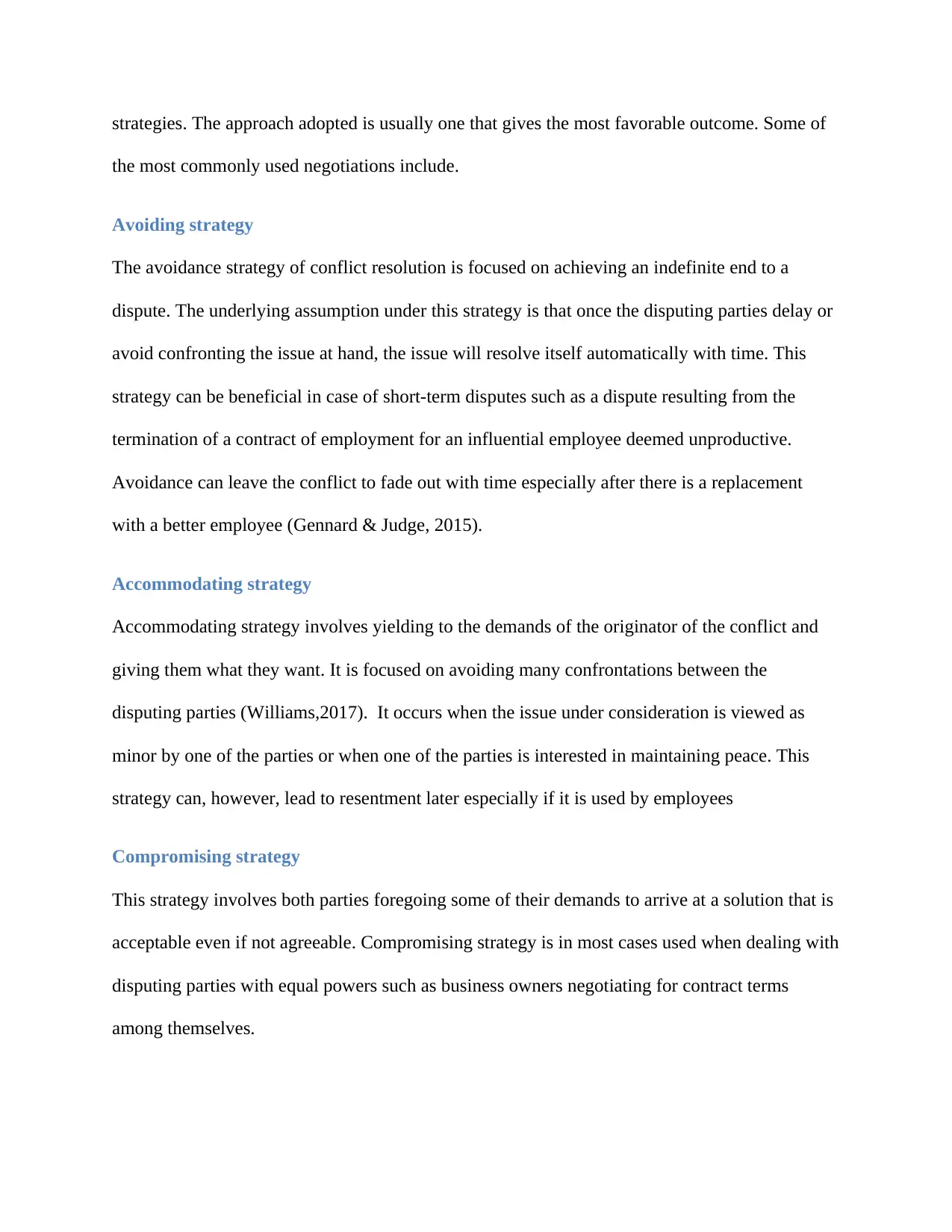
strategies. The approach adopted is usually one that gives the most favorable outcome. Some of
the most commonly used negotiations include.
Avoiding strategy
The avoidance strategy of conflict resolution is focused on achieving an indefinite end to a
dispute. The underlying assumption under this strategy is that once the disputing parties delay or
avoid confronting the issue at hand, the issue will resolve itself automatically with time. This
strategy can be beneficial in case of short-term disputes such as a dispute resulting from the
termination of a contract of employment for an influential employee deemed unproductive.
Avoidance can leave the conflict to fade out with time especially after there is a replacement
with a better employee (Gennard & Judge, 2015).
Accommodating strategy
Accommodating strategy involves yielding to the demands of the originator of the conflict and
giving them what they want. It is focused on avoiding many confrontations between the
disputing parties (Williams,2017). It occurs when the issue under consideration is viewed as
minor by one of the parties or when one of the parties is interested in maintaining peace. This
strategy can, however, lead to resentment later especially if it is used by employees
Compromising strategy
This strategy involves both parties foregoing some of their demands to arrive at a solution that is
acceptable even if not agreeable. Compromising strategy is in most cases used when dealing with
disputing parties with equal powers such as business owners negotiating for contract terms
among themselves.
the most commonly used negotiations include.
Avoiding strategy
The avoidance strategy of conflict resolution is focused on achieving an indefinite end to a
dispute. The underlying assumption under this strategy is that once the disputing parties delay or
avoid confronting the issue at hand, the issue will resolve itself automatically with time. This
strategy can be beneficial in case of short-term disputes such as a dispute resulting from the
termination of a contract of employment for an influential employee deemed unproductive.
Avoidance can leave the conflict to fade out with time especially after there is a replacement
with a better employee (Gennard & Judge, 2015).
Accommodating strategy
Accommodating strategy involves yielding to the demands of the originator of the conflict and
giving them what they want. It is focused on avoiding many confrontations between the
disputing parties (Williams,2017). It occurs when the issue under consideration is viewed as
minor by one of the parties or when one of the parties is interested in maintaining peace. This
strategy can, however, lead to resentment later especially if it is used by employees
Compromising strategy
This strategy involves both parties foregoing some of their demands to arrive at a solution that is
acceptable even if not agreeable. Compromising strategy is in most cases used when dealing with
disputing parties with equal powers such as business owners negotiating for contract terms
among themselves.
⊘ This is a preview!⊘
Do you want full access?
Subscribe today to unlock all pages.

Trusted by 1+ million students worldwide
1 out of 20
Related Documents
Your All-in-One AI-Powered Toolkit for Academic Success.
+13062052269
info@desklib.com
Available 24*7 on WhatsApp / Email
![[object Object]](/_next/static/media/star-bottom.7253800d.svg)
Unlock your academic potential
Copyright © 2020–2025 A2Z Services. All Rights Reserved. Developed and managed by ZUCOL.





